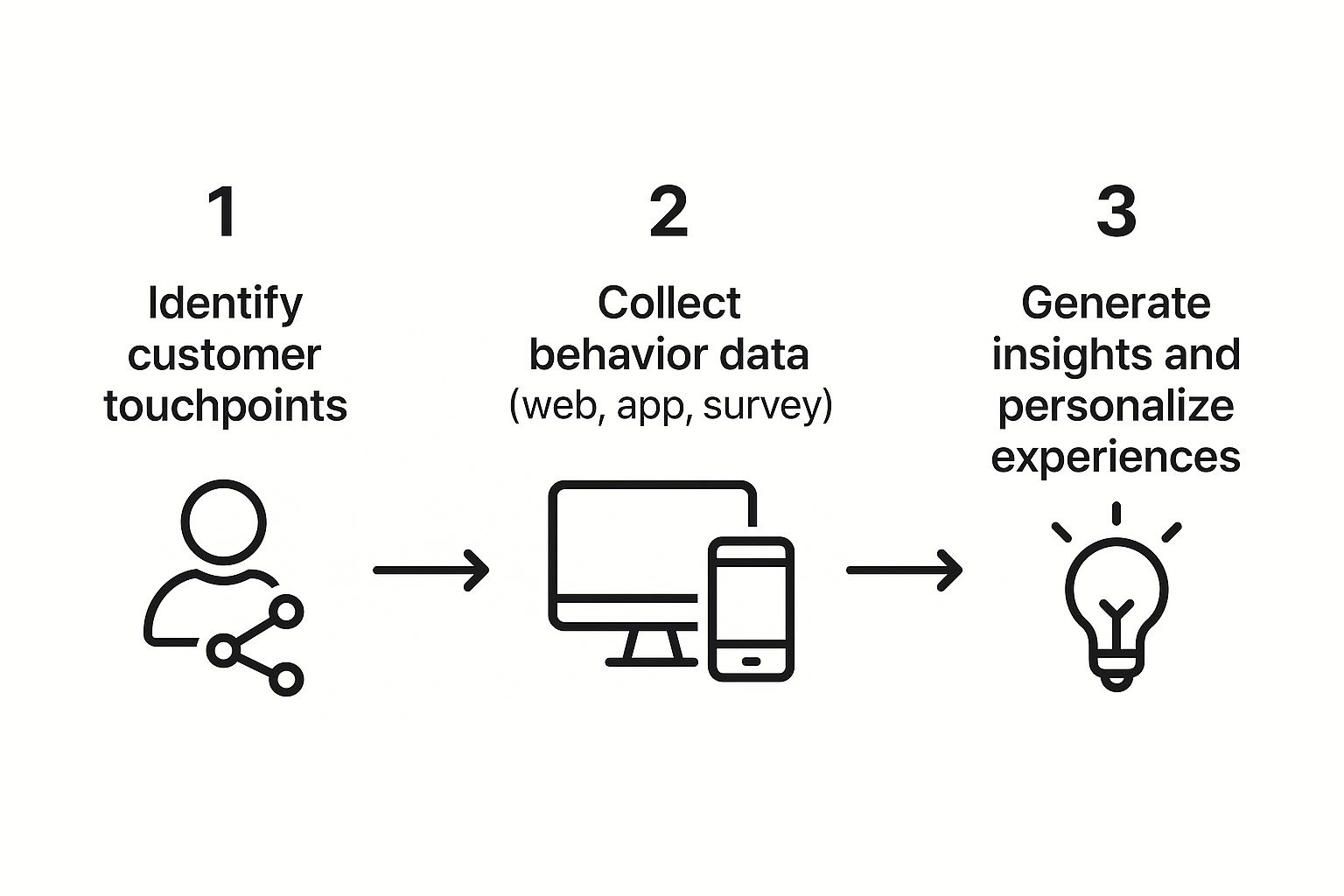Unlock Success with Customer Journey Analytics
Unlock Success with Customer Journey Analytics
Demystifying Customer Journey Analytics
Customer journey analytics is more than just industry jargon. It's a fundamental change in how businesses understand and interact with their customers. Instead of looking at individual interactions, it connects every touchpoint, revealing the complete story of each customer relationship. This broader view allows businesses to go beyond single-channel metrics, which often miss the nuances of modern customer behavior. By focusing on the entire journey, companies can uncover valuable insights that drive real results.
Understanding The Power of Connected Interactions
Imagine a customer browsing your website, adding items to their cart, and then abandoning the purchase. Traditional analytics might simply mark this as a lost sale. However, customer journey analytics goes further. Perhaps the customer received a promotional email the next day and completed the purchase through that link. By linking these interactions, you gain a more accurate view of the customer's journey and the effectiveness of your marketing strategies.
This interconnected view allows businesses to discover hidden issues that competitors might overlook. For example, a slow-loading page during checkout could be the reason for the initial cart abandonment.
Additionally, visual journey mapping turns complex data into usable information. By visualizing the customer's journey, businesses can identify areas for improvement, optimize marketing campaigns, and personalize customer experiences. This understanding of the customer's perspective is critical for increasing customer satisfaction and loyalty. You might be interested in: How to master lead source tracking. This helps you accurately attribute conversions and understand the performance of different marketing channels.
The Growing Importance of Customer Journey Analytics
The increasing popularity of customer journey analytics reflects the growing focus on customer-centricity. Businesses are recognizing the value of understanding and improving customer interactions across various touchpoints. In fact, the customer journey analytics market is experiencing impressive growth. In 2024, the market was valued at approximately $14.54 billion and is projected to reach $17.35 billion by 2025, showing a significant CAGR of 19.4%. This rapid expansion is driven by the shift towards customer-centric business models and the use of multiple data sources for personalized marketing and real-time insights. Find more statistics here. This growth highlights that investing in customer journey analytics is no longer optional, but essential for staying competitive.

The Tangible ROI of Customer Journey Analytics
Customer journey analytics isn't just about collecting data; it's about turning that data into profit. By understanding the entire customer journey, businesses can find opportunities to improve customer experiences, optimize marketing, and boost profits. This translates into a real return on investment (ROI) that makes implementing customer journey analytics worthwhile.
Measuring the Impact of Journey Analytics
The ROI of customer journey analytics shows up in several key areas:
- Reduced Customer Acquisition Costs (CAC): By identifying the most effective marketing channels and touchpoints across the customer journey, businesses can optimize spending and acquire customers more efficiently. For example, if analysis reveals a specific social media campaign is driving high conversions, more resources can be directed to that campaign for maximum impact.
- Increased Customer Lifetime Value (CLTV): Understanding the customer journey lets businesses personalize interactions and offer the right products or services at each stage. This builds customer loyalty, leading to more repeat purchases and a higher CLTV. Keeping existing customers is often more cost-effective than acquiring new ones.
- Lower Churn Rates: Customer journey analytics helps pinpoint friction points and problem areas in the customer experience. By addressing these issues proactively, businesses can improve customer satisfaction and reduce churn. For instance, if a complicated checkout process causes cart abandonment, targeted improvements can streamline the experience and encourage conversions.
For further reading on evaluating marketing effectiveness, check out this article: How to master marketing ROI measurement.
Demonstrating Value and Securing Buy-In
To secure executive buy-in for customer journey analytics, it's essential to clearly demonstrate the potential ROI. This means focusing on metrics that align with business objectives. A table showcasing potential improvements can help make the case.
The following table, "Customer Journey Analytics ROI Metrics", shows key performance indicators and business outcomes often achieved by organizations implementing customer journey analytics.
| Metric | Average Improvement | Implementation Timeframe | Business Impact |
|---|---|---|---|
| Conversion Rate | 10-20% | 6-12 Months | Increased Sales |
| Customer Retention Rate | 5-15% | 12-18 Months | Reduced Churn |
| Customer Satisfaction Score | 10-25% | 6-12 Months | Improved Brand Loyalty |
These are examples, and the actual results will vary depending on the industry and implementation. However, showcasing these potential improvements can make a compelling case for investment.
As the table highlights, significant improvements across conversion rates, customer retention, and satisfaction are possible within a reasonable timeframe. This data demonstrates the potential for substantial positive impact on business outcomes.
Breaking Down Silos and Fostering Collaboration
Beyond direct financial benefits, customer journey analytics creates a more complete view of the customer. This shared understanding breaks down silos between departments like marketing, sales, and customer service.
When all teams access the same customer journey data, they can collaborate more effectively. This collaborative approach strengthens customer relationships and contributes to long-term business success.
By aligning teams around the customer journey, every interaction reinforces a positive brand image. This cohesive approach leads to a more consistent and satisfying customer experience, further enhancing ROI.
Building Your Customer Journey Analytics Foundation
What separates a successful customer journey analytics implementation from an expensive flop? It all comes down to a solid foundation. This means a reliable framework, smooth data integration, clear visualizations, and the power to predict future customer behavior. Understanding these elements unlocks the full potential of customer journey analytics and transforms your customer experience.
Integrating Disparate Data Sources
The first step is building an infrastructure that handles data from various sources. Many businesses grapple with data scattered across multiple systems. This makes a unified view of the customer journey challenging. A strong foundation, however, integrates this information seamlessly. This doesn't always mean a complete system overhaul. Instead, it's about connecting your existing data streams effectively. Imagine building bridges between islands of information, creating a connected path that reveals the entire customer journey.
Identity Resolution: Creating Unified Customer Profiles
After integrating the data, the next step is identity resolution. This links all interactions a single customer has across different channels and devices. For example, someone might browse your website on their laptop, add an item to their cart on their phone, and then buy it in-store. Identity resolution connects these separate interactions, creating one unified customer profile. This complete picture is key to understanding the customer journey and personalizing experiences.
Visualizing the Customer Journey
Complex data is only useful if it's easily understood. That's why visualization is crucial. By turning raw data into intuitive maps and charts, customer journey analytics allows everyone in the organization to grasp the customer's journey. Visualizing the journey is like creating a roadmap. It highlights touchpoints, reveals patterns, and pinpoints areas for improvement. This shared understanding empowers teams to make data-driven decisions to improve the customer experience.
Predictive Modeling: Anticipating Future Behavior
A powerful customer journey analytics foundation goes beyond understanding past behavior. It predicts future actions. Predictive modeling uses historical data to identify patterns and anticipate what customers might do next. This lets businesses proactively intervene at critical moments. A strong foundation supports informed choices, enabling better, more impactful changes, much like data-driven decision making. This proactive approach can dramatically boost customer retention and drive business growth.
Market Growth and Investment
The increasing importance of customer journey analytics is clear in market projections. Industry reports show significant expansion, with estimates ranging from $15.0 billion in 2024 to a projected $52.2 billion by 2033, showing a CAGR of 14.8%. Other projections, though starting a bit lower, also anticipate strong growth. This highlights the growing value businesses place on understanding and optimizing the customer journey. Learn more here. Building a strong foundation isn't just a good idea; it's essential for businesses that want to succeed in a customer-centric world. By integrating data, resolving identities, visualizing the journey, and using predictive modeling, you can transform customer data into actionable insights and drive real business results.

Implementing Journey Analytics That Actually Works
Moving beyond the theoretical benefits of customer journey analytics requires a practical roadmap for implementation. Based on insights from successful companies, this guide offers a step-by-step approach that acknowledges real-world constraints. This means honestly assessing your current data capabilities, building effective teams, and understanding potential pitfalls. By focusing on achievable early wins, you can build momentum for broader adoption of customer journey analytics within your organization.
Assessing Your Data Readiness
Before diving into implementation, it's crucial to conduct a thorough data readiness assessment. This involves identifying your current data sources, evaluating their quality, and understanding any gaps that need to be addressed. This assessment helps you understand your starting point and prioritize the most impactful improvements.
For example, you might discover that data silos are preventing a unified view of the customer. Or, you might find that data quality issues are hindering accurate analysis. Addressing these challenges upfront sets the stage for a more successful implementation.
Building Cross-Functional Teams
Successful customer journey analytics initiatives require a team with both technical expertise and business acumen. This means combining data analysts who can work with the technology like Heap and business stakeholders who understand the strategic goals. This cross-functional collaboration ensures that the analytics efforts align with overall business objectives.
Additionally, involving team members from different departments fosters a more comprehensive approach. Include representatives from marketing, sales, and customer service to gain diverse perspectives.
The following infographic visualizes the key steps in implementing customer journey analytics: identifying customer touchpoints, collecting behavioral data, and generating insights to personalize customer experiences.

This process demonstrates how understanding customer touchpoints and collecting relevant data leads to actionable insights. These insights can then improve personalization and the overall customer experience.
To better understand the implementation process, let's look at a phased approach:
The following table outlines a phase-by-phase approach to successfully implementing customer journey analytics within an organization.
| Implementation Phase | Key Activities | Required Resources | Success Criteria |
|---|---|---|---|
| Data Assessment | Identify data sources, evaluate data quality, address data gaps | Data analysts, data governance team, data integration tools | Comprehensive understanding of existing data landscape |
| Team Formation | Assemble cross-functional team, define roles and responsibilities, establish communication channels | Business stakeholders, data analysts, project manager | Collaborative team structure |
| Implementation | Deploy analytics tools, integrate data sources, develop reporting dashboards | Analytics platform, technical expertise, data visualization tools | Functional analytics system, initial insights generated |
| Analysis & Optimization | Analyze customer journeys, identify pain points and opportunities, optimize customer experiences | Data analysis skills, business knowledge, A/B testing tools | Measurable improvements in customer experience metrics |
This Customer Journey Analytics Implementation Framework highlights the key activities, required resources, and success criteria for each phase. By following this framework, businesses can implement customer journey analytics effectively. The key takeaway here is a structured approach ensures a smoother and more effective implementation process.
Avoiding Common Pitfalls and Setting Realistic Timelines
Implementation isn't always smooth sailing. Common pitfalls include unrealistic expectations, insufficient resources, and lack of clear goals. To avoid these challenges, start with a clearly defined scope and focus on achieving early wins. This builds confidence and demonstrates the value of customer journey analytics.
Furthermore, setting realistic timelines is key. The complexity of your organization and the availability of resources should inform your implementation plan. For example, a small business with a simpler data landscape might achieve initial results within a few months. A large enterprise with complex data integration needs might require a longer timeframe. This phased approach ensures that the project remains manageable and delivers incremental value.
Demonstrating Early Wins and Building Momentum
Highlighting early successes is crucial for securing continued support and expanding the use of customer journey analytics. This might involve showcasing improved conversion rates, reduced customer churn, or increased customer satisfaction. These tangible results build momentum and encourage broader adoption within the organization.
This positive reinforcement creates a virtuous cycle, where early successes lead to greater investment and more comprehensive analysis. By demonstrating clear value, you can pave the way for a more data-driven and customer-centric organization.
Conquering Data Challenges in Journey Analytics

Fragmented and inconsistent data presents a significant obstacle for organizations implementing customer journey analytics. It's often like piecing together a puzzle with missing pieces. However, practical solutions can help you overcome these data challenges and harness the power of journey analytics within your existing technology.
Breaking Down Data Silos
Many organizations face the challenge of data residing in separate systems, hindering a unified customer view. But breaking down these data silos doesn't always require significant infrastructure overhauls. Focus on connecting existing systems, like building bridges between information islands. This enables data to flow freely, providing a comprehensive view of each customer journey.
Improving Data Quality at the Source
The principle of "garbage in, garbage out" applies directly to customer journey analytics. Accurate analysis relies on high-quality data. Improving data quality begins at the source. Implement data validation rules, standardize data formats, and train teams on data entry and collection best practices. This proactive approach prevents errors and inconsistencies, ensuring data integrity for your journey analysis.
Addressing Privacy Concerns
Navigating data privacy regulations is crucial for customer journey analytics. Anonymizing sensitive data and complying with regulations like GDPR and CCPA is essential. This doesn't mean sacrificing valuable insights. Robust data governance policies and anonymization techniques allow you to gain critical journey insights while respecting customer privacy, building trust, and protecting your organization's reputation. Chatbot data often plays a role in journey analytics; learn more about analytics for chatbots.
Connecting Actions with Identity Resolution
Successful companies use identity resolution to connect customer actions across multiple channels. Imagine a customer interacting on social media, visiting your website, and purchasing in-store. Identity resolution links these touchpoints, creating a single, unified customer profile. This comprehensive view allows for a deeper understanding of customer behavior and preferences. For more insights into how touchpoints contribute to conversions, check out our guide on How to Master Multi-Touch Attribution.
Filling the Gaps with Statistical Modeling
Sometimes, data limitations prevent a complete view of the customer journey. Statistical modeling can help bridge these gaps. Analyzing existing data and applying statistical techniques allows for educated inferences about missing information. You could, for instance, predict purchase likelihood based on past browsing behavior. This predictive capability enhances journey analysis and improves decision-making.
By addressing these data challenges, you can unlock the full potential of customer journey analytics, enabling more personalized experiences, optimized marketing, and ultimately, business growth.
Next-Level Customer Journey Analytics Techniques
Building a solid foundation for customer journey analytics is essential. Truly innovative companies, however, are pushing the boundaries even further. They're using advanced techniques to gain a deeper understanding of their customers and create more impactful experiences. This section explores some of these next-level approaches, including predictive journey modeling, sentiment analysis, real-time journey orchestration, and AI-powered pattern recognition.
Predictive Journey Modeling: Anticipating Customer Needs
Predictive journey modeling uses historical data and algorithms to forecast future customer behavior. It's like anticipating your opponent's next move in a chess game. This proactive approach allows businesses to address potential issues and offer targeted solutions before problems arise.
For example, if data suggests a customer is likely to churn, a business can proactively reach out with personalized offers or support. This preemptive engagement strengthens customer relationships and reduces churn rates.
Sentiment Analysis: Adding Emotional Context
Sentiment analysis goes beyond simple behavioral data. It examines the emotions expressed in customer feedback and interactions, adding a crucial layer of understanding to the customer journey.
Identifying negative sentiment on social media or in customer service interactions, for instance, can alert businesses to potential problems and opportunities for improvement. This emotional context creates a more complete picture of the customer experience, leading to more empathetic and effective responses.
Real-Time Journey Orchestration: Dynamic Experiences
Real-time journey orchestration lets businesses adjust the customer experience as it happens, based on live behavior. This dynamic approach delivers highly personalized interactions.
Imagine a customer abandons their online shopping cart. Real-time journey orchestration could trigger a personalized email offering a discount or free shipping, encouraging them to complete the purchase. This responsiveness creates a tailored approach that improves customer satisfaction and drives conversions.
AI-Powered Pattern Recognition: Unveiling Hidden Insights
AI-powered pattern recognition analyzes large datasets to identify hidden patterns and trends in customer journeys. Perhaps there's a group of customers consistently following a specific, less obvious path to purchase. Discovering this allows businesses to optimize these hidden paths and cater to unique customer segments.
These granular insights create a competitive advantage by allowing for highly targeted marketing and personalized experiences.
These advanced techniques represent the future of customer journey analytics. By embracing these tools and strategies, businesses can develop a deeper understanding of customer behavior, create more personalized and engaging experiences, and ultimately drive significant business growth.
Want to better understand your customer journey and unlock the power of data-driven insights? LeadPulse helps you track and analyze your leads, providing valuable data on where your customers are coming from. Visit LeadPulse today to learn more and start optimizing your customer journey.